
The Hôtel des Invalides, commonly called Les Invalides, is a complex of buildings in the 7th arrondissement of Paris, France, containing museums and monuments, all relating to the military history of France, as well as a hospital and an Old Soldiers' retirement home, the building's original purpose. The buildings house the Musée de l'Armée, the military museum of the Army of France, the Musée des Plans-Reliefs, and the Musée d'Histoire Contemporaine. The complex also includes the former hospital chapel, now national cathedral of the French military, and the adjacent former Royal Chapel known as the Dôme des Invalides, the tallest church building in Paris at a height of 107 meters. The latter has been converted into a shrine of some of France's leading military figures, most notably the tomb of Napoleon.

The Place de la Concorde is one of the major public squares in Paris, France. Measuring 7.6 ha in area, it is the largest square in the French capital. It is located in the city's eighth arrondissement, at the eastern end of the Champs-Élysées.

Aube is a French department in the Grand Est region of north-eastern France. As with sixty departments in France, this department is named after a river: the Aube. With 310,242 inhabitants (2019), Aube is the 74th department in terms of population. The inhabitants of the department are known as Aubois or Auboises.
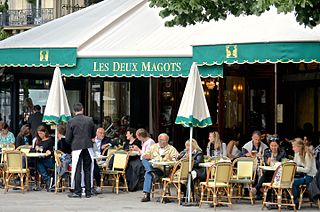
The 6th arrondissement of Paris is one of the 20 arrondissements of the capital city of France. In spoken French, it is referred to as le sixième.

Pont Neuf is a station on Line 7 of the Paris Métro. Located in the heart of old Paris, it is connected to the Île de la Cité by the nearby Pont Neuf after which it is named. It opened in 1926 with the line's extension from Palais Royal–Musée du Louvre to Pont Marie.
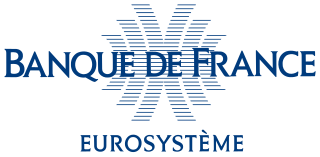
The Bank of France is the French member of the Eurosystem. It was established by Napoleon Bonaparte in 1800 as a private-sector corporation with unique public status. It was granted note-issuance monopoly in Paris in 1803 and in the entire country in 1848, issuing the French franc. Charles de Gaulle's government nationalized the bank in 1945 after several governance changes in the meantime. It remained France's sole monetary authority until end-1998, when France adopted the euro as its currency.

The Musée Carnavalet in Paris is dedicated to the history of the city. The museum occupies two neighboring mansions: the Hôtel Carnavalet and the former Hôtel Le Peletier de Saint Fargeau. On the advice of Baron Haussmann, the civil servant who transformed Paris in the latter half of the 19th century, the Hôtel Carnavalet was purchased by the Municipal Council of Paris in 1866; it was opened to the public in 1880. By the latter part of the 20th century, the museum was full to capacity. The Hôtel Le Peletier de Saint Fargeau was annexed to the Carnavalet and opened to the public in 1989.

The Hôtel-Dieu is a public hospital located on the Île de la Cité in the 4th arrondissement of Paris, on the parvis of Notre-Dame. Tradition has it that the hospital was founded by Saint Landry in 651 AD, but the first official records date it to 829, making it the oldest in France and possibly the oldest continuously operating hospital in the world. The Hôtel-Dieu was the only hospital in the city until the beginning of the 17th century.

Pierre Contant d'Ivry, was a French architect and designer working in a chaste and sober Rococo style and in the goût grec phase of early Neoclassicism.
The year 1775 in architecture involved some significant events.
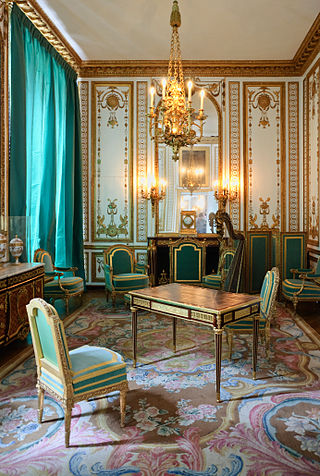
Louis XVI style, also called Louis Seize, is a style of architecture, furniture, decoration and art which developed in France during the 19-year reign of Louis XVI (1774–1792), just before the French Revolution. It saw the final phase of the Baroque style as well as the birth of French Neoclassicism. The style was a reaction against the elaborate ornament of the preceding Baroque period. It was inspired in part by the discoveries of Ancient Roman paintings, sculpture and architecture in Herculaneum and Pompeii. Its features included the straight column, the simplicity of the post-and-lintel, the architrave of the Greek temple. It also expressed the Rousseau-inspired values of returning to nature and the view of nature as an idealized and wild but still orderly and inherently worthy model for the arts to follow.
La contemporaine is a French library, museum and archive center specialized on 20th century history. It was named "Bibliothèque de documentation internationale contemporaine" (BDIC) until 2018. The institutions has two centers, one in the Paris Nanterre University campus which hosts the archives and the library. The museum is located within the premises of the Hôtel National des Invalides in the 7th arrondissement of Paris. The contemporary opens in October 2021, a new facility that brings together all the collections at the entrance to the university campus of the University of Paris-Nanterre.

The Hôtel des Monnaies is an 18th-century building located at 11 Quai de Conti in the 6th arrondissement of Paris, which has housed the Monnaie de Paris since its construction. It is considered a prime example of pre-Revolutionary French Neoclassical architecture.

Jacques Denis Antoine was a French architect, whose most notable masterwork is the Hôtel des Monnaies in Paris, which gained him entrance to the Académie royale d'architecture in 1776. He is also known for his work on private residences such as the Château of Buisson de May in Normandy, built from 1781 to 1783. Most of his works are in the Neoclassical architectural style.

Neoclassical architecture appeared in Belgium during the period of Austrian occupation in the mid-18th century and enjoyed considerable longevity in the country, surviving through periods of French and Dutch occupation, and the birth of Independent Belgium, surviving well into the 20th century.
This article presents the main landmarks in the city of Paris within administrative limits, divided by its 20 arrondissements. Landmarks located in the suburbs of Paris, outside of its administrative limits, while within the metropolitan area are not included in this article.

Neoclassicism is a movement in architecture, design and the arts which emerged in France in the 1740s and became dominant in France between about 1760 to 1830. It emerged as a reaction to the frivolity and excessive ornament of the baroque and rococo styles. In architecture it featured sobriety, straight lines, and forms, such as the pediment and colonnade, based on Ancient Greek and Roman models. In painting it featured heroism and sacrifice in the time of the ancient Romans and Greeks. It began late in the reign of Louis XV, became dominant under Louis XVI, and continued through the French Revolution, the French Directory, and the reign of Napoleon Bonaparte, and the Bourbon Restoration until 1830, when it was gradually replaced as the dominant style by romanticism and eclecticism.
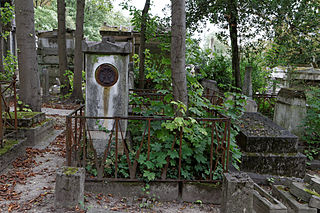
Jacques Cellerier (1742–1814) was a French architect in the neoclassical style whose buildings can be seen mainly in Paris and Dijon.
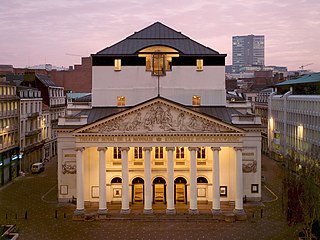
The Place de la Monnaie or Muntplein (Dutch), meaning "Mint Square", is a major square in central Brussels, Belgium. The Royal Theatre of La Monnaie, home to the National Opera of Belgium, is located on this square. It is served by the metro and premetro station De Brouckère on lines 1, 3, 4 and 5.
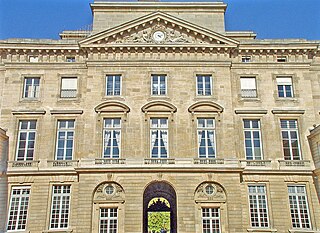
The Musée du 11 Conti is a museum dedicated to the manufacturing techniques and the know-how of the Monnaie de Paris. It is located in the 6th arrondissement in Paris. The museum houses exhibition rooms and workshops. The museum is interactive, showcasing touchable items, tactile graphics and olfactory devices.


















